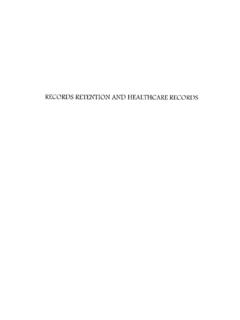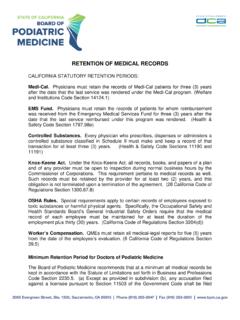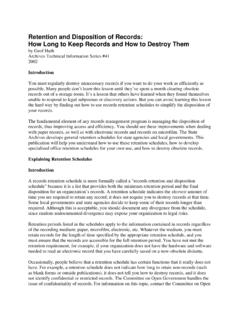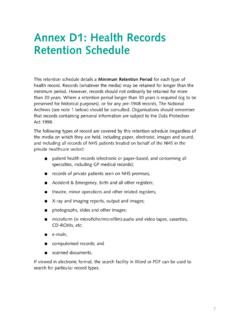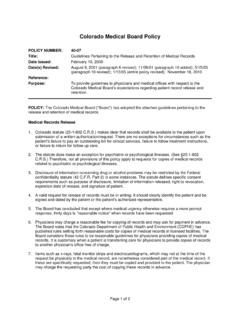Transcription of 1160 Retention of Medical Records - Antelope Valley College
1 PreviousIndexTOCNext California Medical Association 1995-2004 This CMA ON-CALL document is brought to you through the generous support ofphysician-sponsored professional liability companiesMedical Insurance Exchange of California, NORCAL Mutual Insurance Company,and The SCPIE Companies, and by The Doctors ON-CALL: The California Medical Association's Information-On-Demand ServiceOnline: STATUTORY Retention PERIODSC alifornia statutory authorities which specifically regulate a physician s Retention of Medical Records are found, among other places, in the Medi-Cal Act, the law governing the Emergency Medical Services Fund, the California Uniform Controlled Substances Act, the Knox-Keene Act, OSHA rules, and the Worker s Compensation Physicians must retain the Records of Medi-Cal patients for three years after the date that the last service was rendered under the Medi-Cal program. (Welfare & Institutions Code )EMS Fund.
2 Physicians must retain the Records of patients for whom reimbursement was received from the Emergency Medical Services Fund for three years after the date that the last service reimbursed under this program was rendered. (Health & Safety Code )Prescription Books. Prescription books with copies of prescriptions issued must be kept for three (3) years. (Health & Safety Code 11168)Controlled Substances. Every physician who prescribes, dispenses or administers a controlled substance classified in Schedule II must make and keep a record of that transaction for at least three years. SeeHealth & Safety Code 11191. That record must contain the following information:a)The name and address of the patient;b)The date;c)The name, strength and quantity of the controlled substance(s) involved; andd)The pathology and purpose for which the prescription is July 1, 2004, physicians who dispense Schedule II drugs must also record all the following:a)Patient s full name, address, gender and date of birth;b)Physician s category of licensure, license number and DEA number;c)Pharmacy prescription number, license number and DEA number;Document #1160 CMA Legal CounselRetention of Medical RecordsJanuary 20041 Licensed clinics, adult day care centers, home health facilities, hospitals, and other licensed health facilities may have other statutory obligations to keep Medical Records .
3 Physicians who practice in facilities which are licensed by the Department of Health Services should make sure the facility complies with all record Retention )NDC number of controlled substance dispensed;e)Quantity dispensed;f)ICD-9 code, if available; andg)Dispensing January 1, 2005, this additional information will also be required for Schedule III drugs.(Health & Safety Code 11190.)Knox-Keene Act. Under the Knox-Keene Act, all Records , books, and papers of a plan and of any provider must be open to inspection during normal business hours by the Commissioner of Corporations. Providers must maintain such Records and provide such information to the plan or to the Commissioner as may be necessary for compliance by the plan with the provisions of the Knox-Keene Act and its regulations. This requirement appears to pertain to Medical Records as well. Such Records must be retained by the provider for at least two years, and this obligation is not terminated upon a termination of the agreement.
4 (28 )OSHA Rules. Special requirements apply to certain Records of employees exposed to toxic substances or harmful physical agents. Specifically, the Occupational Safety and Health Standards Board s General Industrial Safety Orders require that the Medical record of each employee must be maintained for at least the duration of employment plus thirty years. See 8 3204(d).Worker s Compensation. QMEs must retain all Medical -legal reports for five years from the date of the employee s evaluation. (8 )CONTRACTUAL AGREEMENTS TO RETAIN RECORDSF inally, there may be provisions in contracts you have signed with your Medical malpractice carrier, insurance companies, HMOs, etc. that specify, as a minimum, how long you need to keep Records pertaining to at least some of your patients. This time period, if it exists, will vary with each Retention AND LIABILITY FOR OWNERS OF CLINICAL LABORATORIESO wners and laboratory directors of all clinical laboratories, including those laboratories that cease operations, shall preserve Medical Records and laboratory Records for three years from the date of testing, examination, or purchase, unless a longer Retention period is required pursuant to any other provision of law, and shall maintain an ability to provide those Records when requested by the Department of Health Services or its duly authorized representative.
5 (Business & Professions Code 1265.) Medical Records means the test requisition or test authorization, or the patient s chart or Medical record , if used as the test requisition, the preliminary and final test or examination results, and the name of the person contacted if the laboratory test or examination result indicated an imminent life-threatening result, or was of panic value. Laboratory Records means Records showing compliance with CLIA and California law during a laboratory s operation that are actual or true copies, either photocopies or electronically reproducible copies, of Records for patient test management, quality control, quality assurance, and all invoices documenting the purchase or lease of laboratory equipment and test kits, reagents, or media. (Id.) Information contained in these Records must be confidential and disclosed only as authorized by law.
6 The Department or any person injured as a result of a laboratory s abandonment or failure to retain Records pursuant to this law may bring a lawsuit for any amount of reasonable damages suffered as a & Professions Code imposes a risk of liability upon owners of licensed clinical laboratories for failure to maintain Medical Records , reports, cytology slides and cell blocks for the required periods of time. Specifically, if the laboratory ceases operation and a person is injured as a result of the inability to obtain any of the Records and tissue samples just mentioned due to the clinic s failure to retain them for the minimum statutory period,2 that person may sue on the grounds of abandonment of Records . Personal liability may be imposed upon:a)Any or all partners of the clinic in the case of a general partnership;b)Any or all general partners of a limited partnership; orc)In the case of a corporation, the chairperson of the board, the chief executive officer, and/or the president of the with ownership interests in licensed clinical laboratories should be aware of this potential liability exposure from failure to properly retain Records and tissue specimens in the event the clinic ceases to operate.
7 CAUTION: There are significant limitations on the circumstances in which a physician may have an ownership interest in a clinical lab. For more information see CMA ON-CALL document #0315, Clinical Laboratories: Self-Referral and Fee-Splitting Prohibitions. HIPAA PRIVACY RULESThe privacy regulations enacted pursuant to the Health Insurance Portability and Accountability Act of 1996 (HIPAA Privacy Rules) became effective April 14, 2003. The HIPAA Privacy Rules apply to physicians and other health care providers that use electronic means to perform HIPAA covered transactions, such as the transmission of health claims, remittance or payment advice or any of the other electronic transactions included in the HIPAA Transaction Rules. They also cover those who pay for healthcare (health plans) and clearinghouses. The HIPAA Privacy Rules apply with respect to all protected health information (PHI), whether in paper, oral or electronic form.
8 For more detailed information on HIPAA, including the definition of covered entity, see CMA ON-CALL document #1600, HIPAA Overview. The HIPAA Privacy Rules do not create new rules governing the Retention of Medical Records . However, they do establish rules governing the Retention of all the documentation created in compliance with those rules. Specifically, covered physicians must maintain all the following in written or electronic form for at least six (6) years from the date of its creation or the date it was last in effect:a)all HIPAA Privacy Rule required policies and procedures;b)all HIPAA Privacy Rule related communications required to be in writing; andc)all HIPAA Privacy Rule related actions, activities or designations required to be documented.(45 (j).)2 Business & Professions Code 1271 and 1274 require that Medical Records , cytology slides and cell blocks be retained by licensed clinical laboratories for a minimum of five years, and cytology reports (including a report correcting errors in a previous report) for a minimum of ten This constitutes a rare example where, in a particular circumstance, a statute specifically removes protection from personalliability usually afforded principals of a Retention PERIODSThe statute of limitations in California generally requires that an adult s action for Medical malpractice be brought within three years after the date of injury or one year after the plaintiff discovers, or through the use of reasonable diligence should have discovered, the injury, whichever is shorter.
9 For patients under the age of eighteen, a malpractice action must be brought within three years of the date of the alleged wrongful act, except that patients under the age of six have at least until their eighth birthday. The statute of limitations can be extended, however, if a patient can show fraud or intentional concealment on the part of the physician, or the presence of a foreign object which has no therapeutic or diagnostic effect. In addition, with respect to minors, it may be extended where the parent or guardian and the defendant s insurer or health care provider commit fraud or collusion in the failure to bring an action on behalf of the injured minor. Moreover, the statute applies only to cases of professional negligence. While the courts have interpreted the term professional negligence broadly, it is possible that cases involving contract or other disputes may be subject to other statutes of limitations with broader tolling 1: Retain Records IndefinitelyDespite the lack of a general statutory requirement and the relatively brief three-year period mandated for Medi-Cal, EMSF Records , and certain controlled substance Records , it is recommended that all Medical Records be retained indefinitely.
10 This recommendation is based on two primary considerations: patient protection and physician protection. As the DES cases demonstrate, scientific advances make it impossible for a physician to predict what information will be desirable or necessary to aid in a patient s future treatment. Nor can physicians determine when the statute of limitations will bar a suit for professional negligence. Court decisions continue to erode its presumed protection. For example, in Call v. Kezirian(1982) 135 189, 185 103, the court ruled that the statute of limitations in a mother s suit against her obstetrician for failure to diagnose Down s Syndrome was suspended until the parents actually learned that the abnormality would have been discovered through amniocentesis. The decision of the California Supreme Court in Brown v. Bleiberg (1982) 32 426, 186 228, is even more startling.






